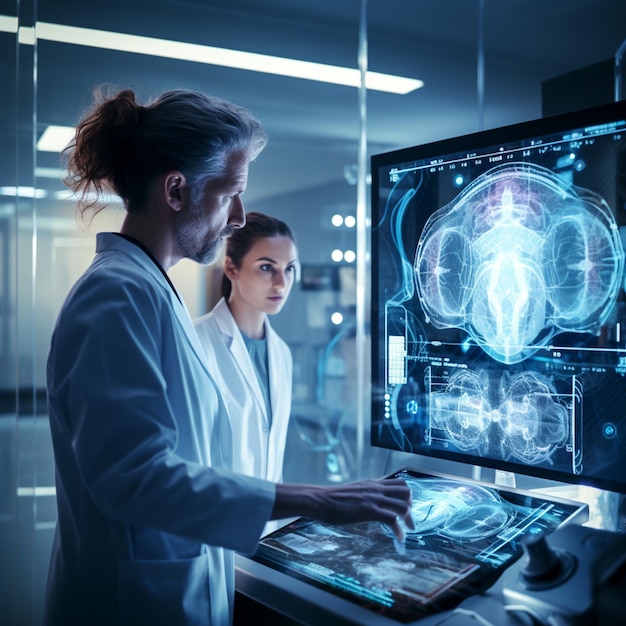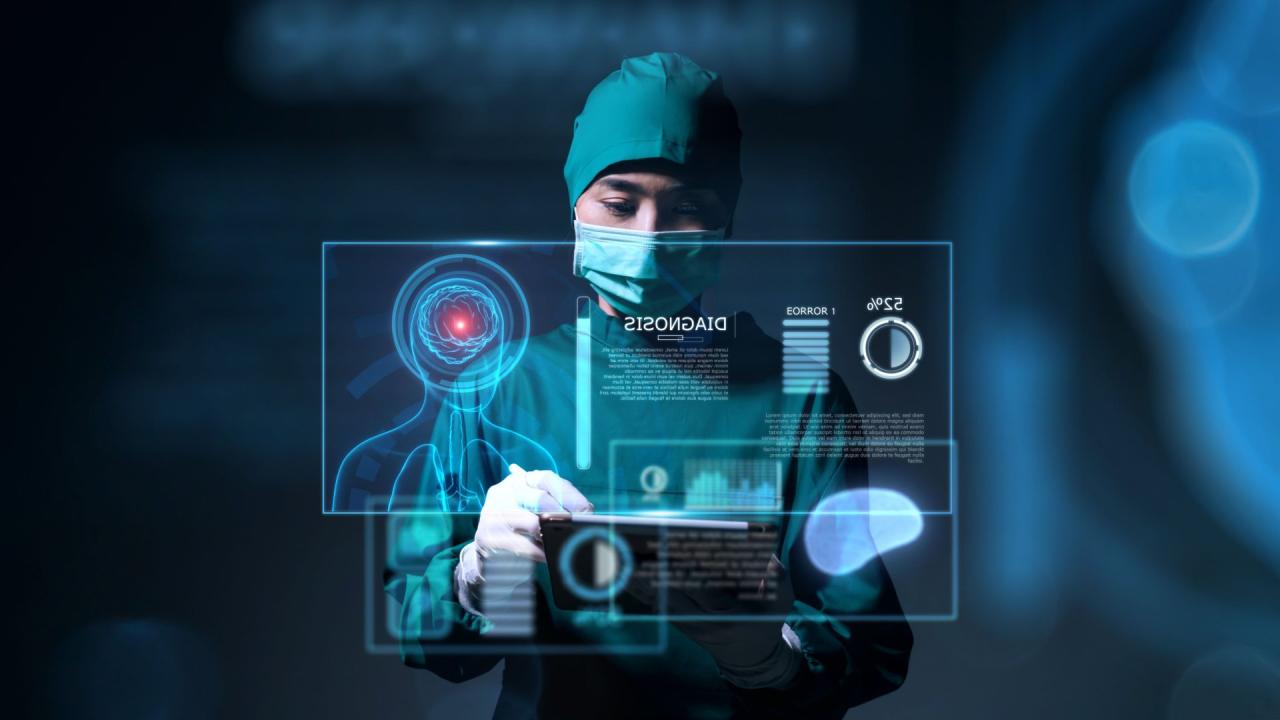Revolutionizing Healthcare with AI-Powered Diagnostics
The healthcare industry stands on the precipice of a monumental shift. For centuries, medical diagnosis has relied primarily on the expertise, experience, and fallible judgment of human clinicians. While this system has saved countless lives, it is not without its limitations. Diagnostic errors, often a result of cognitive overload, human fatigue, or the sheer volume of data, remain a significant challenge. Furthermore, the global shortage of specialized medical professionals means that quality diagnostics are not equally accessible to all. However, a new era is dawning, one driven by the transformative power of artificial intelligence (AI). Far from being a futuristic fantasy, AI has already begun to fundamentally reshape the diagnostic landscape, offering a new generation of tools that promise to enhance accuracy, streamline workflows, and democratize access to world-class medical care. This article delves into the core mechanisms and real-world applications of AI in diagnostics, exploring how it is not just augmenting, but truly revolutionizing, the way we identify and treat disease.
The Foundation: Understanding AI in Medical Diagnostics
At its heart, artificial intelligence is a broad field of computer science dedicated to creating systems that can perform tasks that typically require human intelligence. In the context of healthcare, this means developing algorithms capable of analyzing vast and complex datasets to identify patterns, make predictions, and provide insights that would be impossible for a human mind to process alone. The AI revolution in diagnostics isn’t about replacing doctors; it’s about providing them with an unprecedented level of support, essentially a super-powered diagnostic partner.
The AI tools used in medicine are not monolithic; they are built upon several key technological pillars, each with a unique function:
- Machine Learning (ML): This is a subfield of AI where algorithms learn from data without being explicitly programmed. ML models are trained on datasets containing patient information (e.g., electronic health records, genetic data, lifestyle factors) to predict outcomes. For instance, an ML model could analyze a patient’s risk of developing a chronic disease based on hundreds of variables, far exceeding the capacity of traditional risk calculators. This allows for proactive, preventive care rather than reactive treatment.
- Deep Learning (DL): A more advanced form of ML, deep learning uses multi-layered neural networks inspired by the human brain. This technology is particularly adept at processing unstructured data, such as images, audio, and video. Convolutional Neural Networks (CNNs), a specific type of deep learning model, are the engine behind most AI applications in medical imaging. They can “see” and interpret patterns within an image, distinguishing between healthy tissue and a cancerous lesion, for example, with incredible precision.
- Natural Language Processing (NLP): NLP gives computers the ability to understand, interpret, and generate human language. In a diagnostic setting, this means AI can analyze unstructured clinical data, such as a doctor’s handwritten notes, patient reports, or medical literature. NLP tools can sift through thousands of research papers to find relevant information for a rare disease diagnosis or automatically extract key data points from a patient’s medical history to create a structured summary.
From Data to Diagnosis: How AI is Transforming Medical Fields
The true power of AI lies in its ability to be applied across a wide spectrum of medical disciplines, providing diagnostic breakthroughs that were once thought to be science fiction. Its capacity to analyze data with speed and accuracy has already begun to reshape clinical practice in several key areas.
A. Radiology and Medical Imaging
Medical imaging is arguably the most fertile ground for AI innovation in diagnostics. Radiologists often face a deluge of images—from X-rays and CT scans to MRIs and mammograms—that must be interpreted quickly and accurately. AI is stepping in to assist with this overwhelming workload.
- Cancer Detection: AI algorithms trained on massive datasets of medical images are now being used to identify signs of cancer. For example, AI can analyze mammograms to detect subtle breast tissue anomalies that may be missed by the human eye. Similarly, AI can screen chest CT scans for small, early-stage lung nodules that could indicate cancer. Studies have shown that a combination of AI and human radiologist review can significantly increase the detection rate and reduce false positives.
- Stroke and Brain Ailments: In a medical emergency like a stroke, every second counts. AI tools can analyze head CT scans almost instantly to detect cerebral hemorrhages or blood clots. This rapid analysis helps clinicians make a faster diagnosis, allowing for timely intervention and potentially saving a patient’s life by minimizing brain damage. AI is also being used to analyze brain MRIs to detect early signs of neurodegenerative diseases such as Alzheimer’s and Parkinson’s.
- Fracture Detection: For conditions that are less life-threatening but still require high accuracy, such as bone fractures, AI provides invaluable support. AI algorithms can analyze X-rays to quickly identify fractures, particularly in areas like the wrist or ankle. This is especially useful in high-volume settings like emergency rooms, where it can serve as a second check or a triage tool to prioritize cases for a radiologist’s review.
B. Pathology and Histology
Pathologists play a crucial role in diagnosis by examining tissue samples under a microscope. This process is time-consuming and requires immense concentration. AI is now a powerful partner in this field.
- Tumor Grading and Classification: AI algorithms are trained to analyze digital slides of tissue biopsies. They can count cells, identify mitotic figures, and classify tumors with a high degree of accuracy. For certain types of cancer, like prostate or breast cancer, AI can automatically grade the severity of the tumor, providing a consistent and objective assessment that can inform treatment decisions.
- Immunohistochemistry Analysis: Pathologists use special stains (immunohistochemistry) to identify specific proteins or markers in tissue samples. AI can automate the analysis of these slides, quickly quantifying the presence and location of these markers, which is a critical step in diagnosing and determining the prognosis for many diseases.
C. Cardiovascular and Heart Health
Cardiology is another field where AI-powered diagnostics are making a significant impact.
- ECG Analysis: The electrocardiogram (ECG) is a fundamental diagnostic tool for heart conditions. AI can analyze ECG readings with incredible speed and precision, detecting subtle patterns that may indicate a heart arrhythmia, even those that are difficult for a human to spot. Some AI systems can even predict a patient’s risk of sudden cardiac arrest based on their ECG data.
- Echocardiogram Interpretation: An echocardiogram is an ultrasound of the heart. Analyzing these images requires a high level of expertise. AI can be used to automatically measure key cardiac metrics, such as ejection fraction and ventricle size, providing cardiologists with a quick and objective assessment of heart function.
D. Ophthalmology and Eye Disease
The eye, with its rich network of blood vessels, provides a window into a patient’s overall health. This makes it an ideal target for AI diagnostics.
- Diabetic Retinopathy Screening: Diabetic retinopathy, a leading cause of blindness, can be detected by analyzing retinal images. AI algorithms have been developed that can screen these images for signs of the disease, often with accuracy on par with or even exceeding that of a human ophthalmologist. This technology can be deployed in primary care settings, allowing for early detection and treatment and preventing irreversible vision loss.
- Glaucoma and Age-Related Macular Degeneration (AMD): AI can also analyze retinal images and optical coherence tomography (OCT) scans to detect early signs of glaucoma and AMD, two other major causes of vision loss. By identifying these conditions in their early stages, clinicians can initiate treatment sooner, preserving the patient’s sight.
E. Dermatology and Skin Conditions
The visual nature of skin conditions makes them a perfect fit for AI-powered image analysis.
- Melanoma Detection: AI tools can analyze images of skin lesions to help dermatologists determine whether a mole or spot is likely to be cancerous. AI models trained on millions of images can identify subtle, high-risk features of melanoma that might be overlooked. While not a definitive diagnosis, this serves as an excellent triage tool, helping to prioritize which lesions require immediate biopsy and which are likely benign.
- Psoriasis and Eczema Diagnosis: AI is also being used to help with the diagnosis of common inflammatory skin conditions like psoriasis and eczema by analyzing images of rashes and other skin manifestations. This can help less experienced clinicians make more accurate diagnoses and tailor treatment plans.
The Benefits: Why AI is the Future of Diagnostics
The integration of AI into diagnostic medicine offers a host of benefits that are reshaping the healthcare ecosystem. These advantages go far beyond mere technological novelty.
- Enhanced Accuracy and Consistency: AI models, when properly trained, can achieve levels of diagnostic accuracy that rival, or even surpass, human experts. Crucially, they do so with perfect consistency. An AI algorithm doesn’t get tired after a long shift or suffer from cognitive biases. This ensures that every patient’s case is reviewed with the same rigorous standard.
- Improved Efficiency and Speed: AI can analyze vast quantities of data in a fraction of the time it takes a human. For example, an AI system can analyze a CT scan for a suspected stroke in minutes, while a radiologist may take significantly longer. This speed is critical in time-sensitive situations. Additionally, AI can automate mundane, repetitive tasks, freeing up clinicians to focus on more complex cases and direct patient interaction.
- Democratization of Expertise: The global distribution of medical expertise is uneven. There are far more cardiologists and radiologists in developed urban centers than in rural or developing regions. AI-powered diagnostic tools can act as “expert extenders,” bringing high-quality diagnostic capabilities to areas where there are few or no specialists. A primary care clinic in a remote village could use an AI tool to screen for diabetic retinopathy, providing a level of care previously unavailable.
- Personalized and Predictive Medicine: By analyzing a patient’s unique data—including genetics, lifestyle, and medical history—AI can help predict their risk of future disease and identify the most effective, personalized treatment plan. This shift from a “one-size-fits-all” approach to tailored care is the cornerstone of precision medicine, and AI is its most powerful engine.
The Challenges: Paving the Way for Widespread Adoption
Despite its immense potential, the widespread adoption of AI in diagnostics faces significant hurdles that must be addressed.
- Data Privacy and Security: AI models require massive amounts of patient data for training. Protecting this sensitive information from breaches and misuse is a paramount ethical and legal concern. Robust security protocols and anonymization techniques are essential.
- Regulatory Approval: AI-powered diagnostic tools are considered medical devices. They must undergo rigorous validation and regulatory approval (e.g., from the FDA in the United States) to ensure they are safe and effective. The approval process can be lengthy and complex, slowing down the adoption of new technologies.
- Bias in AI Models: AI algorithms are only as good as the data they are trained on. If the training data is not diverse and representative of the real world, the AI model can develop biases, leading to inaccurate or discriminatory results for certain demographic groups. For example, an AI trained primarily on data from white males may perform poorly on diagnosing conditions in women or people of color.
- Ethical and Legal Responsibility: When an AI tool provides a diagnosis, who is ultimately responsible for the outcome? If a diagnostic error occurs, does the liability rest with the developer of the algorithm, the hospital, or the clinician who used the tool? These are complex legal questions that require new frameworks and guidelines.
- Integration into Clinical Workflow: For AI tools to be useful, they must integrate seamlessly into the daily workflow of clinicians. The user interface must be intuitive, and the technology must complement, not complicate, existing processes.
The Future Horizon: A Partnership for Progress
The future of diagnostics is not one where machines replace humans, but one where they work together in a synergistic partnership. AI will take on the role of the tireless, objective data analyst, sifting through the noise and highlighting what is most important. The clinician, in turn, will be free to focus on what they do best: applying clinical judgment, empathizing with patients, and providing the human connection that is so vital to healing.
We are entering a golden age of diagnostic medicine, characterized by proactive care, early detection, and unparalleled accuracy. The revolution is already underway, and its impact will be felt in every corner of the healthcare system, leading to better outcomes and a healthier future for all.









